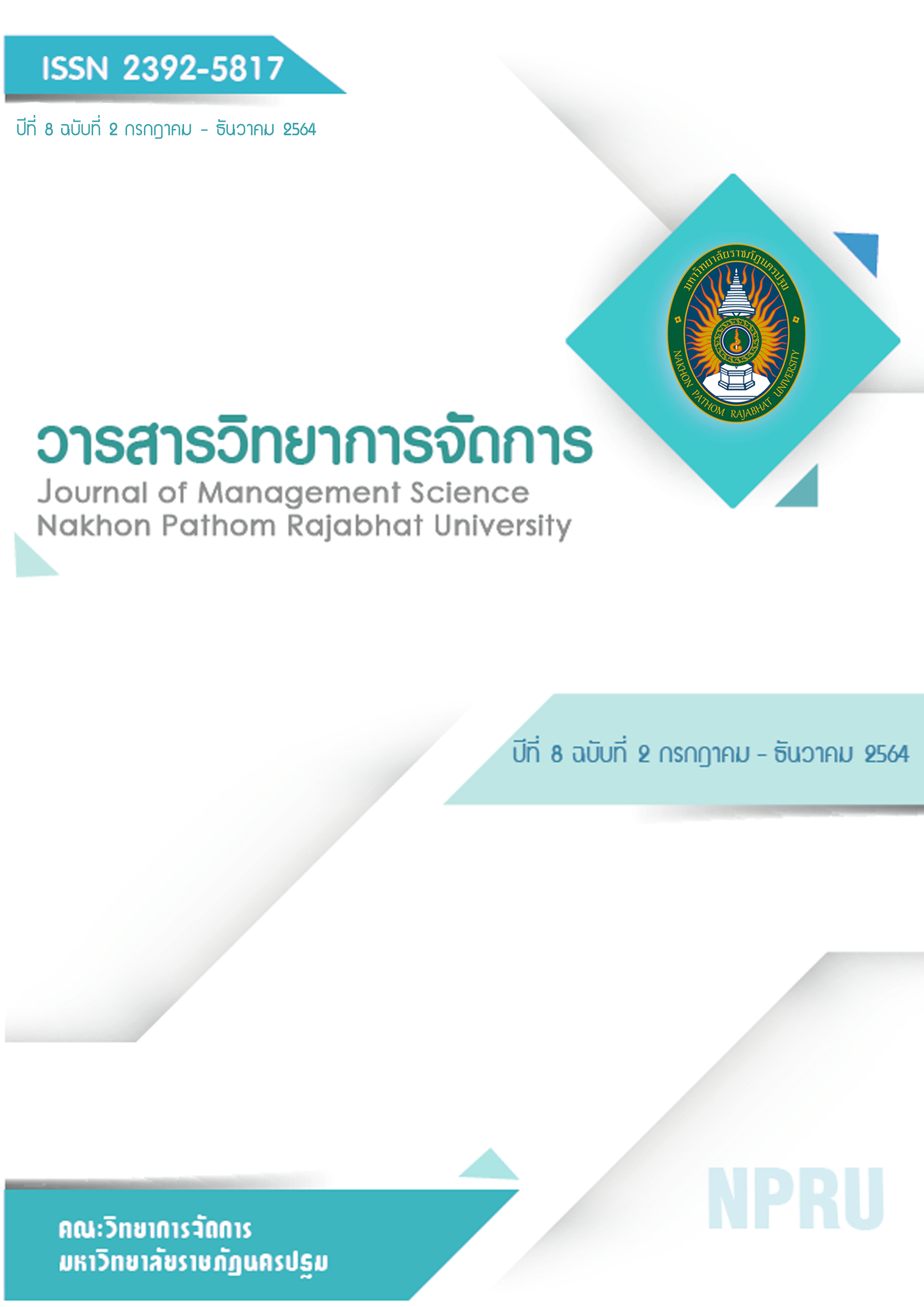ภาวะผู้นำแห่งการเปลี่ยนแปลงยุค 4.0 ของผู้บริหารองค์การบริหารส่วนตำบล ในเขตอำเภอบ้านแหลม จังหวัดเพชรบุรี
Main Article Content
บทคัดย่อ
การวิจัยครั้งนี้มีวัตถุประสงค์เพื่อศึกษา (1) ระดับภาวะผู้นำแห่งการเปลี่ยนแปลงของผู้บริหารองค์การบริหารส่วนตำบลในเขตอำเภอบ้านแหลม จังหวัดเพชรบุรี (2) ความสำเร็จของระบบราชการ 4.0 ของผู้บริหารองค์การบริหารส่วนตำบลในเขตอำเภอบ้านแหลม จังหวัดเพชรบุรี (3) ความสำเร็จของระบบราชการ 4.0 ที่มีอิทธิพลกับภาวะผู้นำแห่งการเปลี่ยนแปลงของผู้บริหารองค์การบริหารส่วนตำบลในเขตอำเภอบ้านแหลม จังหวัดเพชรบุรี กลุ่มตัวอย่างที่ใช้ในการวิจัย ได้แก่ บุคลากรที่เป็น ข้าราชการ พนักงานจ้างตามภารกิจ และลูกจ้างชั่วคราวขององค์การบริหารส่วนตำบลในเขตอำเภอบ้านแหลม จังหวัดเพชรบุรี จำนวน 130 คน จากประชากรทั้งสิ้นจำนวน 282 คน และใช้วิธีการสุ่มกลุ่มตัวอย่างแบบโควต้า วิเคราะห์ข้อมูลโดยใช้ค่าสถิติเชิงพรรณนา ได้แก่ ค่าร้อยละ ค่าเฉลี่ย ค่าเบี่ยงเบนมาตรฐาน และสถิติเชิงอนุมาน โดยใช้สถิติการวิเคราะห์การถดถอยพหุคูณ
ผลการวิจัยพบว่า
1. ระดับภาวะผู้นำแห่งการเปลี่ยนแปลงของผู้บริหารองค์การบริหารส่วนตำบลในเขตอำเภอบ้านแหลม จังหวัดเพชรบุรี ในภาพรวมและรายด้าน มีภาวะผู้นำแห่งการเปลี่ยนแปลงอยู่ในระดับมาก เรียงตามลำดับ ดังนี้ ด้านการเป็นแบบอย่างที่ดี ด้านการประเมินวิสัยทัศน์ ด้านการสร้างวิสัยทัศน์ ด้านการปฏิบัติตามวิสัยทัศน์ และด้านการเผยแพร่วิสัยทัศน์
2. ความสำเร็จของระบบราชการ 4.0 ของผู้บริหารองค์การบริหารส่วนตำบลในเขตอำเภอบ้านแหลม จังหวัดเพชรบุรี ในภาพรวมและรายด้านมีการปฏิบัติอยู่ในระดับมาก เรียงตามลำดับดังนี้ การประสานพลังระหว่างภาครัฐและภาคส่วนอื่น ๆ ในสังคม ด้านการปรับตัวเข้าสู่ระบบดิจิทัล และด้านการสร้างนวัตกรรม
3. ความสำเร็จของระบบราชการ 4.0 ด้านการสร้างนวัตกรรม มีอิทธิพลกับภาวะผู้นำแห่งการเปลี่ยนแปลงของผู้บริหารองค์การบริหารส่วนตำบลในเขตอำเภอบ้านแหลม จังหวัดเพชรบุรี อย่างมีนัยสำคัญทางสถิติที่ระดับ 0.001 ด้านประสานพลังระหว่างภาครัฐและภาคส่วนอื่น ๆ ในสังคม และด้านการปรับตัวเข้าสู่ระบบดิจิทัล มีอิทธิพลกับภาวะผู้นำแห่งการเปลี่ยนแปลงของผู้บริหารองค์การบริหารส่วนตำบลในเขตอำเภอบ้านแหลม จังหวัดเพชรบุรี อย่างมีนัยสำคัญทางสถิติที่ระดับ 0.01 สมการมีอำนาจการพยากรณ์ร้อยละ 57.70 สมการการวิเคราะห์ถดถอยพหุคูณ คือ
Ŷ = 0.527 + 0.259 (x1) + 0.318 (x2) + 0.282 (x3)
* วิทยานิพนธ์หลักสูตรรัฐประศาสนศาสตรมหาบัณฑิต คณะรัฐประศาสนศาสตร์และสังคมศึกษา มหาวิทยาลัยนานาชาติแสตมฟอร์ด วิทยาเขตหัวหิน 76120 ภายใต้การควบคุมของอาจารย์ ผู้ช่วยศาสตราจารย์ ดร.บำเพ็ญ ไมตรีโสภณ
Corresponding author: khitta.2499@gmail.com
Article Details
ทัศนะและข้อคิดเห็นของบทความที่ปรากฏในวารสารฉบับนี้เป็นของผู้เขียนแต่ละท่าน ไม่ถือว่าเป็นทัศนะและความรับผิดชอบของกองบรรณาธิการ
เอกสารอ้างอิง
นิกัญชลา ล้นเหลือ. (2554). โมเดลสมการโครงสร้างภาวะผู้นำเชิงวิสัยทัศน์ของผู้บริหาร สถานศึกษาขั้นพื้นฐาน. ปรัชญาดุษฎีบัณฑิต สาขาวิชาบริหารการศึกษา มหาวิทยาลัยขอนแก่น.
พรชัย เจดามาน นิตยาพร กินบุญ และ ไพฑูรย์ พิมดี. (2559). ภาวะผู้นำแห่งการเปลี่ยนแปลง ศตวรรษที่ 21: ไทยแลนด์ 4.0. กรุงเทพฯ: สูตรไพศาลบิวเดอร์.
สำนักงานคณะกรรมการพัฒนาระบบราชการ (2559). สำนักงานวิจัยและพัฒนาระบบงานบุคคล สำนักงาน ก.พ. 2560 ประเทศไทยในบริบทไทยแลนด์ 4.0. สำนักงานคณะกรรมการพัฒนาระบบราชการ
อ้อยฤดี สันทร. (2560). กลยุทธ์การพัฒนาภาวะผู้นำการเปลี่ยนแปลงของผู้บริหาร เทศบาลนครในเขตจังหวัดภาคตะวันออกเฉียงเหนือ. วิทยานิพนธ์รัฐประศาสนศาสตรดุษฎีบัณฑิต มหาวิทยาลัยราชภัฏวไลยอลงกรณ์ ในพระบรมราชูปถัมภ์ จังหวัดปทุมธานี.

